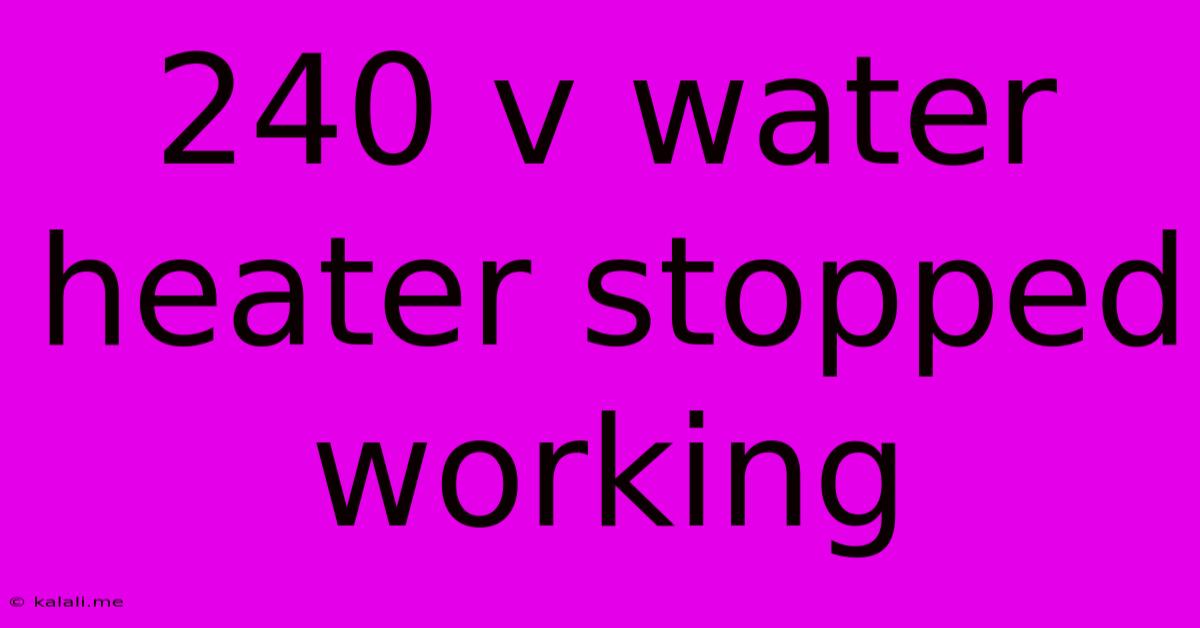240 V Water Heater Stopped Working
Kalali
May 23, 2025 · 3 min read

Table of Contents
My 240V Water Heater Stopped Working: Troubleshooting and Solutions
Your 240V water heater suddenly refusing to cooperate? A cold shower is the last thing you want, especially on a chilly morning. This guide will walk you through troubleshooting common issues with your 240V electric water heater, helping you diagnose the problem and potentially fix it yourself. Remember, safety is paramount – if you're uncomfortable working with electricity, call a qualified electrician.
Understanding Your 240V Water Heater System: Before diving into troubleshooting, understanding the basic components is crucial. Your system consists of a tank, heating elements (usually one or two), a thermostat, a pressure relief valve, and a circuit breaker. A malfunction in any of these components can lead to a non-functioning heater.
Common Reasons Why Your 240V Water Heater Isn't Working
Let's tackle the most frequent culprits behind a defunct water heater:
1. Tripped Circuit Breaker: This is the easiest fix. Check your electrical panel for a tripped breaker dedicated to your water heater. It will be in the "off" position. Simply switch it back "on." If it trips immediately, there's a more serious electrical problem requiring professional attention.
2. Faulty Thermostat: The thermostat controls the heating elements. A malfunctioning thermostat prevents the elements from turning on, resulting in no hot water. Testing the thermostat involves using a multimeter to check for continuity. If it's faulty, replacing it is usually straightforward, but requires some electrical knowledge.
3. Burned-Out Heating Elements: Over time, heating elements can burn out due to mineral buildup or simply age. This is a common reason for a water heater ceasing to function. Again, a multimeter is needed to test the heating elements for continuity. Replacing a heating element requires turning off the power supply and carefully following the manufacturer's instructions. Be cautious – these elements get extremely hot.
4. Lower Element Problems (for two-element heaters): Many 240V water heaters have two heating elements: an upper and a lower. Often, the lower element fails first due to sediment accumulation at the bottom of the tank. Testing and replacing the lower element often resolves the issue.
5. Pressure Relief Valve Issues: While not directly related to heating, a faulty pressure relief valve can prevent the water heater from working properly. If the valve is stuck open, it will continuously release water and pressure, preventing the tank from heating efficiently. A dripping pressure relief valve is a sign of a potential problem.
6. Sediment Buildup: Mineral deposits at the bottom of the tank can insulate the heating elements, reducing their efficiency and causing them to overheat and fail. Regular flushing of your water heater is crucial to extend its lifespan. This involves draining a portion of the water and removing the sediment.
7. Thermostat Wiring Issues: Loose or corroded wires connected to the thermostat can interrupt the electrical circuit. Carefully inspect the wiring connections for any damage and securely reattach any loose wires.
When to Call a Professional
While some repairs are manageable for DIY enthusiasts, certain situations require professional help:
- Recurring tripped circuit breakers: This suggests a more serious electrical problem.
- You're uncomfortable working with electricity: Safety should always be the priority.
- Extensive water damage: Leaking tanks require immediate attention to prevent further damage.
- Complex repairs beyond your skillset: Attempting complex repairs without sufficient knowledge can worsen the situation and even lead to injury.
Addressing a non-functional 240V water heater promptly is crucial for your comfort and to prevent further damage. By following these troubleshooting steps and knowing when to seek professional assistance, you can get your hot water flowing again efficiently. Remember to always prioritize safety and consult a professional when necessary.
Latest Posts
Latest Posts
-
Meddle Not In The Affairs Of Dragons
May 23, 2025
-
How Do I Get A House In Riften
May 23, 2025
-
Where Does The Term Mother F Come From Slavery
May 23, 2025
-
Latex Cls Show Abstract If Write Otherwise Omit
May 23, 2025
-
How To Power Lights Fallout 4
May 23, 2025
Related Post
Thank you for visiting our website which covers about 240 V Water Heater Stopped Working . We hope the information provided has been useful to you. Feel free to contact us if you have any questions or need further assistance. See you next time and don't miss to bookmark.